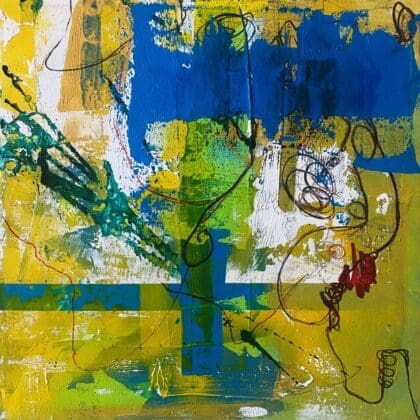In today’s saturated market, simply creating great art isn’t enough to capture attention. You need to have a strong artist brand that helps you stand out from the crowd. Your brand is more than just your art style—it’s your unique identity, your story, and the values you share with your audience.
In this article, we’ll guide you through the steps of crafting an artist brand that resonates, grabs attention, and, most importantly, helps you build a loyal following.
1. What Is an Artist Brand?
Your artist brand is the impression you leave on your audience—it’s what people think and feel when they encounter your work. It goes beyond the colors you choose or the style of your artwork; it’s the whole experience of you as an artist.
Think of your brand as:
Your Identity: It’s the way you present yourself and your art to the world.
Your Promise: What can people expect from you, whether it’s the themes you explore or the type of experience your work provides?
Your Connection: How do you engage with your audience? What emotions or values do your pieces evoke?
Example: Banksy’s brand is instantly recognizable, not just because of his street art style but because of the rebellious, anti-establishment message that runs through his work. His brand isn’t just the artwork itself—it’s the social commentary, the mystery, and the challenge to norms that his name brings.
2. How to Define Your Unique Artist Brand
Before you can stand out, you need to get clear on what makes you different. This is the foundation of your brand—your unique voice in the art world.
Here’s how to start defining your artist brand:
Identify Your Core Values: What themes or ideas drive your art? Are you passionate about social justice, the environment, or exploring identity? Your values help shape your brand story.
Reflect on Your Influences: Who or what has influenced your art style or perspective? Sharing these influences can help communicate your journey and make your brand more relatable.
Understand Your Audience: Who is your art for? Knowing your audience is key to building a brand that connects with the right people.
Pro Tip: Make a list of three to five words that best describe your artistic approach, themes, and personality. These words will act as the guiding principles for how you present your brand.
3. Create a Consistent Visual Identity
A consistent visual identity helps people recognize your brand at a glance. From your logo to your color palette, everything should align with the message you want to send.
Here’s what to consider for your visual identity:
Logo: A simple, distinctive logo can make a big difference. If you don’t have one, think about creating a signature or emblem that reflects your style.
Color Palette: Choose a set of colors that can be repeated across your website, social media, and promotional materials. These should match the mood of your artwork.
Typography: Believe it or not, fonts can impact your brand’s vibe. A modern font might suggest innovation, while a handwritten one could give off a personal, intimate feel.
Example: Yayoi Kusama uses dots and polka patterns throughout her work and branding. It’s a signature that’s immediately recognizable and consistent across all of her exhibitions and merchandise.
4. Tell Your Story
People connect with stories more than they connect with just products or services. As an artist, your story—your journey, inspiration, and the challenges you’ve faced—can become one of the most powerful parts of your brand.
When crafting your artist story, think about:
Your Journey: What brought you to this point? Share how you’ve developed as an artist and the experiences that have shaped your work.
Your Inspiration: What fuels your creativity? Whether it’s nature, personal experiences, or cultural roots, sharing your inspiration makes your work more relatable.
Your Why: Why do you create? Understanding the deeper purpose behind your art can resonate with people who share your values or are drawn to your vision.
Pro Tip: Use your website’s “About” page or Instagram bio to give a snapshot of your artist story. Keep it clear and engaging, while letting your personality shine through.
5. Engage with Your Audience
Your artist brand is more than just what you post—it’s how you engage with your followers. Consistent, meaningful interaction helps build a community around your art and strengthens your brand’s presence.
Ways to engage with your audience:
Share Your Process: Let your followers in on your creative process. Show behind-the-scenes photos, sketchbook pages, or time-lapse videos of your work in progress.
Respond to Comments: Whether it’s on social media or email, take time to respond to feedback and questions. Authentic engagement shows that you care about your audience.
Offer Insights: Share your thoughts on art, current events, or the themes in your work. This positions you as more than just a creator, but also as a thought leader.
Example: Artists like Ai Weiwei use social media to engage with their audience beyond just showcasing their work. Weiwei shares personal insights, activism, and the process behind his art, keeping followers engaged and connected to his brand.
6. Consistency Is Key
One of the most important aspects of a successful brand is consistency. This doesn’t mean that you can’t evolve as an artist—rather, it means that you need to maintain coherence in how you present yourself.
Maintain consistency by:
Posting Regularly: Whether it’s daily, weekly, or monthly, regular posting helps keep your audience engaged. Choose a schedule that works for you and stick to it.
Staying on Brand: Keep your messaging, visual identity, and tone consistent across platforms. If your brand is upbeat and colorful, keep that same energy in your captions, website, and promotional materials.
Evolving with Purpose: If your brand evolves, make sure the changes are deliberate and communicated to your audience. If your style shifts, share the story behind the shift.
Pro Tip: Use tools like Hootsuite or Buffer to schedule your social media posts in advance, helping you stay consistent even when you’re busy creating.
7. Promote Your Brand Effectively
Once you’ve defined your brand, it’s time to promote it in a way that reaches your target audience. Effective promotion can help you grow your following, connect with potential buyers, and build your reputation in the art world.
Here are a few strategies:
Collaborations: Team up with other artists or brands that align with your values. Cross-promotion can help expose your brand to new audiences.
Leverage Social Media: Platforms like Instagram, TikTok, and Pinterest are visually-driven and offer great opportunities for artists to showcase their work. Use relevant hashtags to increase visibility.
Create a Professional Website: Your website acts as a hub for your portfolio, story, and contact information. It’s a crucial tool for selling work and landing opportunities.
Example: Shepard Fairey, the artist behind the OBEY brand, uses collaborations with companies and social movements to broaden his reach, while always staying true to his message of social justice and activism.
Conclusion: Define Your Artist Brand and Own It
In a crowded market, your artist brand is what sets you apart. It’s not just about the art you create, but about how you connect, engage, and leave a lasting impression on your audience. By defining your values, building a consistent visual identity, and telling your story, you can build a brand that not only attracts attention but creates a loyal following.
Now it’s time to take action! Reflect on your core values, craft your brand story, and develop a visual identity that communicates who you are. Engage with your audience authentically and consistently, and don’t be afraid to promote your brand to the world. With these tools, you’ll be ready to stand out in any market and make a lasting impact.




